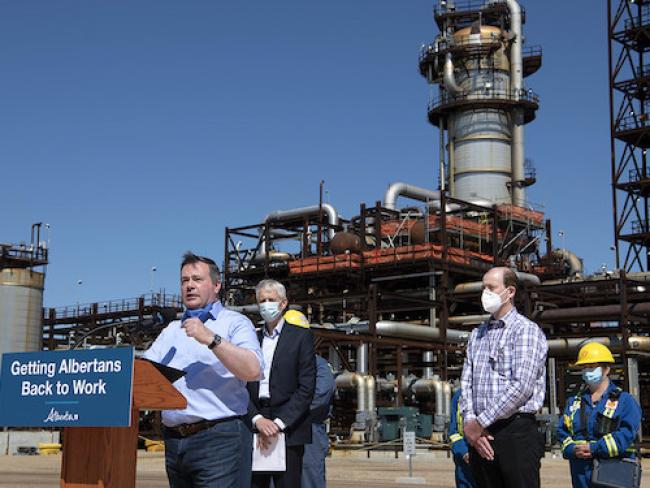Articles Menu

Jan. 24, 2022
The federal government is looking into independent analysis claiming that carbon capture at a highly-touted Shell Canada demonstration project in Alberta is producing more greenhouse gas emissions than it prevents, The Energy Mix has learned.
The report issued late last week by London, UK-based human rights organization Global Witness acknowledges that Shell’s Quest carbon capture and storage (CCS) facility near Edmonton captured five million tonnes of carbon dioxide between 2015 and 2019, in what the company celebrated as a major milestone in July 2020.
“Congratulations to Shell and its joint venture partners for reaching this historic milestone,” Premier Jason Kenney enthused at the time. “We’re thrilled that Shell is taking the time to share this success story. Carbon capture and storage (CCS) is working, and Quest is a model facility that others are learning from across the globe to scale up CCS.”
But Global Witness came up with rather different numbers. “Our new research reveals that Quest is in fact emitting more than it is capturing,” the organization states. Despite the five megatonnes captured, the facility “has emitted a further 7.5 million tonnes of climate-polluting gases during the same time,” the equivalent of 1.2 million internal combustion cars per year.
Shell says it captured emissions equivalent to 1.25 million cars over a five-year span.
Global Witness’s analysis concludes that Quest captured just 48% of the emissions from hydrogen production at its Scotford bitumen upgrader and refinery—far less than the 90% standard promised by fossil executives and lobbyists. That’s because, while the CCS system captured 80% of the emissions from the steam methane reforming (SMR) production process to which it’s attached, it didn’t touch the 40% of total emissions that go into the atmosphere as flue gas, Global Witness says.
“When the plant’s overall greenhouse gas emissions are factored in, such as methane pollution from the fossil gas supply chain, only 39% of its emissions are captured,” the report adds.
For that result, Global Witness says Shell invested US$1 billion in the facility, including US$654 million in government subsidies, despite sustained opposition from many Indigenous communities focused on the industry’s “severe environmental damage”.
Shell maintains the plant has exceeded expectations, capturing more than its target of a million tonnes per year at lower cost than expected. But “Global Witness believes these claims about the CCS facility are misleading,” the report states. “They create the impression the hydrogen plant is less damaging for the climate than is actually the case, while Shell’s promotional materials give no sense of the proportion of carbon dioxide emitted” by Quest.
Global Witness says Shell didn’t respond to its invitation to comment on the study before it was released.
The report lands amid mounting controversy of negotiations leading toward a federal tax credit for carbon capture, storage and utilization (CCUS) technology. Last week, Natural Resources Minister Jonathan Wilkinson told Bloomberg News the credit would likely be included in the next federal budget. On Friday, more than 400 climate scientists and other academics wrote to Deputy Prime Minister and Finance Minister Chrystia Freeland urging her to rethink the plan.
“Deploying CCUS at any climate-relevant scale, carried out within the short time frame we have to avert climate catastrophe without posing substantial risks to communities on the front lines of the buildout, is a pipe dream,” declared the group of signatories led by Dr. Christina Hoicka, Canada Research Chair in Urban Planning for Climate Change at the University of Victoria.
“We must instead move forward with proven climate solutions that will contribute the most to emissions reductions: increased electrification, wide-scale use of renewable energy, and intensifying energy efficiency.”
Late last week, Freeland spokesperson Adrienne Vaupshas told The Canadian Press that “consultations with the industry and other stakeholders with respect to the design of this CCUS measure have been positive and productive”. Vaupshas did not respond to questions from The Energy Mix about whether Finance Canada was aware of the Global Witness critique when she issued that statement, and what pathway or time frame the department sees for CCUS meeting the government’s target of storing 15 million tonnes per year.
Wilkinson’s department, Natural Resources Canada, isn’t commenting on the Global Witness report while it’s under review. But officials are taking the position that like any other emerging emissions reduction option, every new CCUS pilot, demonstration, and deployment project helps improve the technology and drive down future costs.
“Carbon capture, utilization, and storage is not a silver bullet to the climate crisis, but it is an important tool on the pathway to reaching Canada’s ambitious climate goals and reducing emissions in many industries—including oil and gas,” Wilkinson’s press secretary, Joanna Sivasankaran, told The Mix in an email.
The academics’ letter last week noted that four out of five U.S. CCUS projects have been written off as failures. And 81% of the carbon captured to date through CCUS has been pumped underground to force more oil to the surface—leading to a whole new round of emissions—through a process called Enhanced Oil Recovery (EOR).
“Despite decades of research, CCUS is neither economically sound nor proven at scale, with a terrible track record and limited potential to deliver significant, cost-effective emissions reductions,” the letter stated.
By contrast, “effective solutions to achieve deep emission reductions in the next decade along a pathway to zero emissions are already at hand, including renewable energy, electrification, and energy efficiency. Funding CCUS diverts resources from these proven, more cost-effective solutions that are available on the time frames required to mitigate climate change.”
[Top photo: Alberta Newsroom/flickr]